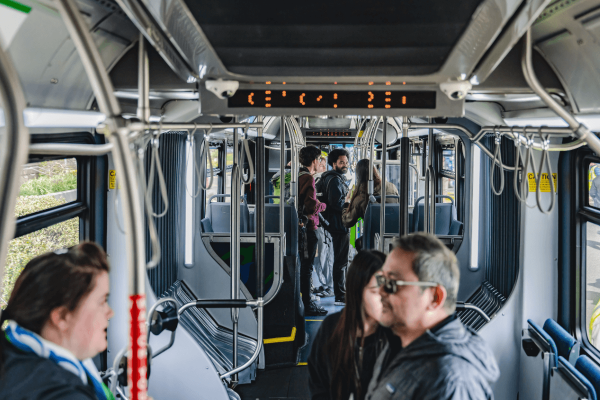Every day, I ride the bus east to west, then back again through Madison, Wisc. I have found joy in the ritual of saying good morning to the driver before swiping my bus pass, sitting by the window, and journaling while reading the Daily Office on my phone during my hour-long commute. I have found peace taking the bus home alongside many tired workers who are also heading back while watching the sun set over my city, decking the sky in auburn hues. But the thing that excites me most about taking public transit is watching the people who come in at every stop. It is exciting to recognize the middle schooler with the headphones, the young mother with the infant in a stroller, and the construction workers with their hard hats tucked under their arms. They are my neighbors. On public transportation, I am reminded that they are the people I am called to love.
A 2022 American Community Survey study showed that only 3.1 percent of Americans use public transportation to travel to work. This is relatively low compared to other countries like South Korea (41 percent), Poland (39 percent), and Austria (34 percent) where people use public transit in their commute to work, school, and university. I grew up in Manila, where there were many trains, jeepneys, and tricycles available for getting around the city. After my family and I immigrated to a small rural college town in Wisconsin, we drove everywhere — to the library and school, to get groceries at Walmart, and to worship at church on Sundays. Gone were the days of elbowing people to get into a packed MRT during rush hour. Gone were the days of trying not to fall off the back of the tricycle because of how fast the driver went in the inner streets of my city. In America, there were just the four of us, an insular unit in a car. Around 68.7 percent of U.S. workers drive to work alone. This was vastly different from the integrated life in community that we had back home. Although there were some risks with fast drivers and although many hours were burned sitting in heavy traffic, I didn’t realize how much I missed and value public transportation until I started riding it again this year.
“The everyday experience of taking public transportation allows you to see the diversity of the people in your community and grow in empathy toward them,” says Alyssa Belda, an organizer for Move As One Coalition, a mobility advocacy group that fights for safer, more humane, and more inclusive public transportation in the Philippines. She’s seen how being disconnected from our community impedes our faith, makes us Sunday Christians, and creates an echo-chamber church that is unable to witness to the world around us. By walking, taking public transit, and riding a bike, she exercises a faith that goes beyond the walls of the church. Around the city, she organizes against jeepney phaseout, advocates for protected bike lanes, and joins protests against the building of the Pasig River Expressway (PAREX) which will displace many urban poor communities. Using public transit compelled her to care for her neighbors by fighting for legislation that would pave the way for the flourishing of communities. It is a spiritual discipline that invites people out of myopic self-centeredness and into self-giving generosity.
“Churches should care more about public transportation because it is reflective of their values,” said Riz Comia, a teacher and disability organizer with Move as One Coalition.Growing up, she attended a small community church near her house by walking and taking the tricycle. Ministers from her church did house-to-house visits in the barangay and compassion work among the urban poor in their community. This was unlike the type of ministry done by the multi-site non-denominational evangelical church she attended in college, where many congregants would arrive by car. Their activities focused more on personal piety and spiritual enrichment, catering to their congregation’s highly educated and upper-middle-class demographic. Comia concluded that car-centric churches tend to have more inward-facing, congregant-centered ministries while churches accessible by multiple modes of transportation have outward-facing, community-centered ministries.
Public transportation shapes our worship, our theology, and how we live out Christ’s call to love our neighbor. If we are to learn to love our neighbor, we must then ask who they are, as the expert of the law did in Luke 10:29. Jesus responded with the Parable of the Good Samaritan and invited the man to go and do likewise — to be the one who shows mercy. To be a neighbor is to show mercy, which requires a kind of knowing. I learned who my neighbors were by taking the bus. By being with them, I grew in knowledge of them. By growing in knowledge of them, I grew in love for them.
When we sojourn together on the same bus, whether we speak or not, neighbors become more real to me. I became acquainted with their early morning sleepiness and their quiet tiredness at the end of the long day. I become familiar with their routes and take mental notes of what they carry. I become appreciative of how each one is created in God’s image and I, likewise, feel seen. When my phone died, a middle-aged woman kindly lent me her phone so I could call my mother. Two construction workers smiled and let me board the bus first because they saw me carrying my bike. I asked a woman what she was reading, and she told me how she had moved with her family from Utah. I learn about my fellow passengers’ lives through kind smiles and gestures of friendliness, which may seem minuscule in the grand scheme of things but are nonetheless impactful. In a country that has become increasingly polarized, sharing space with people we wouldn’t otherwise meet is crucial in pulling us out of our socio-political silos. It keeps us grounded and teaches us to pray for the people around us.
Jesus used different modes of transportation — walking, sailing on a boat, riding on a donkey — to reach people in a variety of contexts. He was God in motion who journeyed with people and ministered to them where they were. On the road to Emmaus, he models for us how to walk with our neighbor. He shows us what it means to go out of one’s way, the way of convenience, to be with someone.
I want to spend this fleeting life sojourning with fellow passengers. “We have not long to love,” writes poet Tennessee Williams, and this temporal reality compels me to love my neighbor as we ride together on this bus, sharing briefly this moment of transience. In the morning, I step on the bus with holy expectation for these divine appointments and spend my commutes in prayerful attention to the people of my city, to whom I am called to be a neighbor. I ask God for their safety as they travel, for sufficient food on their table, and for peace as they go through the day. I ask God for capacity, that I may make myself available to them. I want to be willingly interrupted by those sitting next to me on the bus, so that when Christ asks who is my neighbor, I can tell him I know who they are.
Got something to say about what you're reading? We value your feedback!







